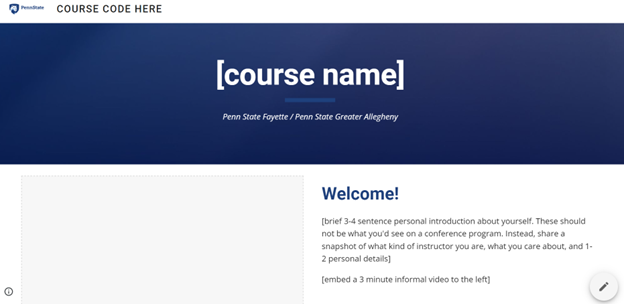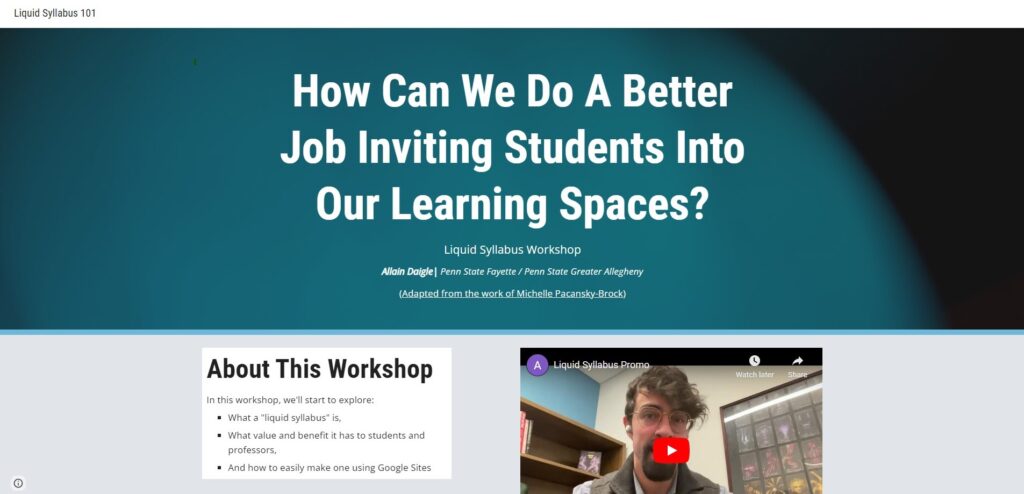Below are resources drawn from a March 2023 workshop around building liquid syllabi from Allain Daigle (Instructional Designer at Penn State Greater Allegheny and Fayette). This post draws on the work and strategies of Michelle Pacansky-Brock, who has built stellar resources around liquid syllabi and their benefits for inclusion and student success. If you would like to learn more, we highly recommend you check out her website at Liquid Syllabus – Michelle Pacansky-Brock.
Why should I use a liquid syllabus?
A liquid syllabus is a great way to humanize our courses — to create a meaningful instructor-learner relationship — before the first day of classes. A liquid syllabus can either replace or supplement a formal syllabus. What it does is create an opportunity for connection before a class begins, and invites students into a space of learning with affirming language.
As Michelle Pacansky-Brock writes:
“Creating trust and identity safety at the start of an online course is an instructional practice that supports the success of more students. Students from non-majority groups are more likely to enter a college course from a place of distrust and have less cognitive bandwidth to dedicate to learning because of the ways that social marginalization wears away at a human’s capacity to learn and make decisions.”
A liquid syllabus that is designed to humanize you and your course to students and present information in a mobile-friendly format. Below, we outline some steps for making a briefer version of a liquid syllabus that invites students into registering for a class.
What is a liquid syllabus?
A liquid syllabus is an informal and brief webpage that is used to invite students into a course. Compared to a traditional 8.5”x11” printed syllabus (a static format that frequently persists as an embedded or downloadable file on Canvas), a liquid syllabus is built to appear clearly no matter what device (laptop, tablet, phone) you use to access it. You don’t need to pinch and zoom to see the document properly; the content shrinks and expands to fit its technological container.
To see an example from Michelle Pacansky-Brock access her site by navigating to this link: History of Still Photo.
Within this informal and brief webpage (aka the liquid syllabus), students will find the following:
- A human-friendly course introduction,
- A mobile friendly format, and
- Key course information
In the information below, we share more details about each of these elements of a liquid syllabus.
A Humanized Introduction On Day 0
Although a syllabus provides important statements and establishes important shared expectations, more often than not, they’re not inviting or concise documents. They regularly greet students with the rules they need to follow to avoid punishment. Well intentioned policies can be a maze of jargon to wander through before getting to the ideas that motivate many of us to enjoy learning.
Whether you use it as a total reformat of your syllabus or just a ‘teaser’ for your course, a liquid syllabus greets students with a personal overview that invites them into a course. It can be particularly helpful to provide to students as they are registering for courses.
Two important elements to include in a liquid syllabus are:
- A course introduction written concisely and friendly (and without jargon!)
- A friendly and personal introduction to you as the instructor.
The introduction to the course provides another way to reduce student anxiety because it helps to “humanize” you as the instructor. Humanizing in online learning means to develop meaningful instructor-learner relationships to create a sense of belonging for the student. This instructor-learner relationship can begin through early one-way communications to students that take many forms, one such form is a liquid syllabus.
Language is important, and Pacansky-Brock has some great resources in her self-paced course on building liquid syllabi. By foregrounding opportunities for connection and inclusion, we can help to reduce student anxiety about starting the course.
Often, students share that they are intimidated by their instructors. But for their overall success, it is important for them to get to know you a little and begin to see you as a human being.
Mobile-friendly Format

The next element to remember is to create the liquid syllabus in a mobile-friendly format. We want to emphasize the importance of using a website for creation of the liquid syllabus because this allows for ease of access. By providing a link to the syllabus, students do not need to download a document and they do not need to use an application other than a standard web-browser. If the liquid syllabus is your only version of your syllabus, we suggest that you test the print preview or keep a simplified text version to share with students who may ultimately want to print the syllabus. Webpages can be saved to PDF and printed as well. The directions on how to do that can be found here.
Additionally, the web link is a mobile-friendly format, meaning the content can be easily displayed on a variety of devices. We should not assume that students will always be sitting at a computer to look at course information. By taking into consideration that many students engage in courses using a variety of devices (such as smartphones and tablets), we ensure students are given equal advantage because they can view the information from any variety of devices.
The easiest platforms to use for building a liquid syllabus are Google Sites or Adobe Express, but a liquid syllabus could also be built with sites.psu.edu.
Key Course Information
The final element to consider when creating a liquid syllabus is what key course information to include. Many of us would say: “All the information in our syllabi is important!” And, this might be true.
But, what information is most important for a student to know before starting a class?
And, once we have their attention, what do we want them to focus on?
A liquid syllabus designed to help students register for a course should be brief, concise, and have key information that matches Lionpath (Name, When The Course Meets, etc.). But, a liquid syllabus can also provide key information that can’t be included in Lionpath. Here is a list of additional information to consider including:
- A quick and informal video introducing yourself as the instructor,
- Information about your teaching style and the format of the course,
- Key benefits from taking a class (low costs, key career skills, etc.), and
- An introduction to your personality as an instructor.
One of our strengths as Commonwealth Campuses are our close relationships with students. A liquid syllabus helps break the ice between us and our students before they even get into the classroom. A liquid syllabus helps invite students into our courses in ways that encourage their success and sense of belonging.
How To Get Started
We’ve provided a description of a few of the key elements of a liquid syllabus above. You might be ready to begin creating your own liquid syllabus. We suggest that you look at a variety of examples to make a list of sections that you’d like to include in your own liquid syllabus.
You can explore examples of Liquid Syllabi by visiting the following links.
Penn State Examples
(Note: These are draft examples that are currently in-progress. They are in varying stages of completion; special thanks to the faculty for their willingness to share!)
External Examples
If you’d like to start with a template, feel free to use the Liquid Syllabus Template created by Instructional Designer Allain Daigle. Click the link to access the template, and then click the “Use Template” button (usually at the top right corner of the screen). To get back to your draft, go to https://sites.google.com/ with the account you used to copy the template.
If you do use the template to create a liquid syllabus, please let Allain (akd6078@psu.edu) know! He’d love to see your creative work. 🙂
Conclusion
The liquid syllabus is a way to connect with students before the start of a class. It helps to provide a warm and welcoming tone to the start of a course while allowing students to begin to forge a relationship with the instructor. In thinking about creating a liquid syllabus, remember to provide a friendly introduction of yourself and the course, to create the liquid syllabus in a mobile friendly format, and to include other important course information for students to know about the course.



0 Comments